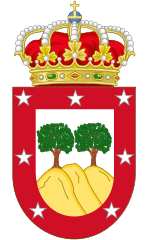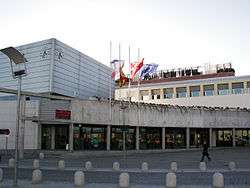Tres Cantos
| Tres Cantos | |
|---|---|
| Municipality | |
|
Casa Consistorial (town hall) | |
 Tres Cantos Location in Spain | |
| Coordinates: 40°35′58″N 3°42′42″W / 40.59944°N 3.71167°W | |
| Country |
|
| Autonomous community |
|
| Comarca | Madrid metropolitan area |
| Government | |
| • Mayor | Jesús Moreno García (PP) |
| Area | |
| • Total | 37.93 km2 (14.64 sq mi) |
| Elevation | 710 m (2,330 ft) |
| Population (2013) | |
| • Total | 41,896 |
| • Density | 1,100/km2 (2,900/sq mi) |
| Demonym(s) | tricantino/tricantina(s) |
| Time zone | CET (UTC+1) |
| • Summer (DST) | CEST (UTC+2) |
| Postal code | 28760, 28761, 28790 |
| Website | www.trescantos.es |


Tres Cantos is a Spanish municipality of the province and Community of Madrid, situated 22 km at the North of the capital. It is a city with a privileged location and has an environment of a huge quality and a high environmental value, because is near of Monte del Pardo, in the south, and in Viñuelas. As a "satellite city" of Madrid which was conceived by urban planners as recently as the 1970s, it is the youngest incorporated municipality in the Community of Madrid,[1] with a population (2012 National Statistics figures) of approximately 41,065. Tres Cantos was the Spanish bid host city for the 2018 Ryder Cup. However, residents showed poor popular support[2][3] (the event was finally awarded to Saint-Quentin-en-Yvelines, France).
The city, as other planned cities, has a peculiar structure. It consists of three phases, each one subdivided (mostly) in different sectors. Most sectors, especially in the first phase (North), include internally pedestrian public spaces, being surrounded by streets. The name of urban places usually are related to the sector where they are (for example, the Sector Océanos has five streets named after the five oceans).
History
Tres Cantos is a 'new community' or planned township, which was first commissioned by the dictatorship of Francisco Franco in 1971 to be established on rural land ceded by the city of Colmenar Viejo. Residential occupation began from 1982, and in 1991 it was incorporated as a separate municipality, the newest in all of Spain. Infrastructure development has continued apace, with a current (2005) 5-year development plan by local government authorities allowing for expansion of up to 60,000 inhabitants. The first mayor of Tres Cantos was Antonio Osuna with an 80% level of support from the population.
Geography and location
Tres Cantos was built on former rural lands, about halfway from the northern outskirts of suburban Madrid to the Guadarrama mountain range, which are frequently snow-capped in winter. It lies in a slight valley formed with two eastwards-flowing creeks, bounded to the south by a higher plateau leading to Madrid, and to the west and north by more hilly terrain, which separates the area from the watershed of the Manzanares River. General elevation of the township is around 680 m, with a highest elevation within the municipality's borders of 730 m. The terrain rises towards the foothills of the Guadarrama range to the north and northwest, reaching elevations in excess of 800 m across the border in Colmenar Viejo. Within the urban area the terrain is gently undulating. It also an enormous new phase where there has been construction of new houses for new people for a long time
The climate of Tres Cantos is typical for continental Spain. Summers are warm, with maximum temperatures of 31 °C which can sometimes reach the 37 °C. Night temperatures are more pleasant, because they decrease till 17 °C. There are cold winters, with minimum temperatures of 0 °C and below,and maximum temperatures of around 9 °C. Due to its geographical location, 22 kilometers from the capital, with is altitude and proximity to the mountains, the annual medium precipitation is superior than in Madrid (above 500 mm).
Demographics

In 2004 the residential population of Tres Cantos was 38,882 according to National Institute of Statistics (Instituto Nacional de Estadística, or INE) figures; however later estimates put the figure at around 45,000. Population growth has been in decline since the peak of the initial influx of residents in the early 1990s, however future plans for expansion are designed to cater for an eventual population of around 60,000.
A feature of Tres Cantos' demographic profile is the large proportion of young professionals (aged 45 and under) with children, compared to Madrid and the national average. This population structure reflects the nucleus of those who left the crowded confines of Madrid to settle in the new community of Tres Cantos in the 1980s and 1990s, resulting in a predominance of young, double-income and home-owning families of 2 to 3 children. Some 40% of the town's population are under 20 (almost double the national average), and less than 6% are over the age of 65 (considerably less than half the national average). The birth rate is also double the national average.
Some 10% of the population are foreign-born (extranjeros), with those from Latin American countries representing over half of these, and those from other European countries a further 33%. Again, many of the immigrant population are professionals employed by multinational companies in fields such as technology, who have settled in Spain after first arriving on work assignment, many of whom are married to Spanish nationals.
Educational accreditation among Tres Cantos inhabitants is also above the national average, with some 60% of prime income earners holding a tertiary qualification or higher. Average income levels reflect these education levels and professional employment opportunities, with over 55% having salaries in the upper-middle or higher income range. Many households have dual-incomes. Approximately 15% of households are classified as lower-middle and low-income households.
An overwhelming majority of the employed work in the services sector, either in Madrid or in Tres Cantos itself. A majority of working residents regularly commute to Madrid for work, with only about a quarter of the workforce having employment in Tres Cantos itself. Those who remain behind are joined by a daily influx of approximately 20,000 who commute from Madrid and its environs to Tres Cantos for work. Light and medium industries account for some 20% of employment in Tres Cantos, the construction sector providing a further 7.4%; a bare handful (0.2%) are employed in agriculture.
Economy and Industry
Tres Cantos' main economic activity is derived from the existence of various high-tech factories and headquarters in designated zones,including from the pharmaceutical, aerospace and computing industries.
Approximately 20,000 employees from outside of Tres Cantos (predominanty Madrid) commute daily to work in its industrial zones its "Technological Park," home of cutting-edge companies in the aerospace industry, such as GMV Innovating Solutions. Other multinational corporations with offices and/or production in Tres Cantos are: Lucent Technologies, BP Solar, BDF Nivea, Nokia Siemens Networks, Samsonite, Altair, Siemens, Dannon, GMV, IFS. Most recently, the largest cable provider in Spain, SOGECABLE, relocated here. The headquarters of both the Real Automóvil Club de España and the Spanish Metrology Centre are located in Tres Cantos.
Sister cities
Tres Cantos is a sister city to the planned cities of Columbia, Maryland, United States, Cergy-Pontoise, France and Nejapa, El Salvador
Sports Clubs
- U.D Tres Cantos Islas
- F.C Base
- Tres Cantos C.D.F.
- Club Baloncesto Tres Cantos
- Tien 21 Uicesa Tres Cantos (futsal club)
- CEA TEAM C.F.
- Club Volleyball Tres Cantos
- Club de Rugby Tres Cantos
- Club Fútbol Americano Tres Cantos: Los Jabatos
- Club Atletismo grupo Oasis Tres Cantos / http://www.atletismogrupooasistrescantos.es/
References
- ↑ "About Tres Cantos" (in Spanish). Ayuntamiento de Tres Cantos. Retrieved 2011-11-24.
- ↑ About 500 people march against the construction of a golf course
- ↑ New demonstration at Tres Cantos against the golf course project
External links
- Official web page of the Tres Cantos municipal government (in Spanish)
- detailed map of the municipal region
- Portal de información local de Tres Cantos
- CAM Public Libraries>Public Library "Lope de Vega" | Bibliotecas de la CAM > Biblioteca Municipal "Lope de Vega"
- Pictures & Info about Public Library "Lope de Vega" building | Documentación y fotos de la Biblioteca Municipal "Lope de Vega" -Tres Cantos (Madrid)-
Coordinates: 40°35′58″N 3°42′42″W / 40.59944°N 3.71167°W

